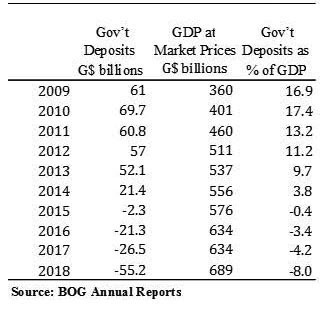
This essay draws from ongoing academic work between myself and a talented young financial analyst, Mr. Joel Bhagwandin. He has been instrumental in putting together data going back to 1985. The dataset shows that each year from 1985 to 2016, the CF had a negative balance or an overdraft. This data will be made public soon in our forthcoming paper on the “Monetary aspects of the persistent overdrafts.” Some readers might recall that the Minister of Finance announced over a year ago that the Budget Speech will no longer carry the summary page of the CF. It is for this reason our dataset stops at 2016.
Nevertheless, as I learned from O’Level and LCC (London Chambers of Commerce) economics, the central bank is the government’s bank. The net of all central government’s expenditures and revenues must be reflected as a liability of the BoG. We reconstructed some data using Annual Reports of the BoG that indicate a major turning point in the stock of government deposits in 2015. The stock of government deposits moved from a positive to a negative balance in the fourth quarter of 2015 (November to be exact). Therefore, it is not only the CF which is likely to be in continued overdraft, but also total government deposits at the central bank.

